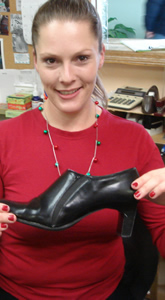High-heeled shoes are shoes which raise the heel of the wearer’s foot significantly higher than the toes. When both the heel and the toes are raised equal amounts, as in a platform shoe, it is generally not considered to be a “high-heel.” High-heels come in a wide variety of styles, and the heels are found in many different shapes, including stiletto, block, tapered, blade, and wedge.
While high heels are today mostly associated with female shoe styles, and the term high heeled shoe is generally understood to mean styles of spike-heeled footwear almost exclusively worn by women, there are numerous shoe designs worn by all genders which have elevated heels, including boots worn by rodeo riders, cowboys, and disco dancers out on a Saturday night. A “low heel” is considered less than 1″, while 1″ to 2.5″ heels are considered “mid heels,” and anything over 2.5″ is considered a “high heel. High-heeled shoes slant the foot forward and down while bending the toes up. The more that the feet are forced into this position, the more it may cause the Achilles tendon to shorten. This may cause problems when the wearer chooses lower heels or flat-soled shoes. When the foot slants forward, a much greater weight is transferred to the ball of the foot, increasing the likelihood of damage to the underlying soft tissue which supports the foot. In many shoes, style dictates function, either compressing the toes, or forcing them together, possibly resulting in blisters, corns, hammer toes, bunions, and many other medical conditions, most of which are permanent, and will require surgery to alleviate the pain.
If it is not possible to avoid high heels altogether, then the wearer should ensure wearing high-heels no more often than twelve hours a day, and that they are spending at least a third of the time on their feet in contour-supportive “flat” shoes (such as exercise sandals), or well-cushioned “sneaker-type” shoes, saving high heels for special occasions.

One of the most critical problems of high-heeled-shoe design involves a properly constructed toebox. Improper construction here can cause the most damage to one’s foot. Toeboxes which are too narrow force the toes to be “crammed” too close together. Ensuring that room exists for the toes to assume a normal separation so that high-heel wear remains an option rather than a debilitating practice, is an important issue in improving the wearability of women’s high-heeled fashion shoes.
Wide heels do not necessarily offer more stability, and any raised heel with too much width, such as found in “blade-” or “block-heeled” shoes, induces unhealthy side-to-side torque to the ankles with every step, stressing them unnecessarily, while creating additional impact on the balls of the feet. Thus, the best design for a high-heel is one with a narrower width, where the heel is closer to the front, more solidly under the ankle, where the toe box provides room enough for the toes, and where forward movement of the foot in the shoe is kept in check by material snug across the instep, rather than by toes jamming together in the toe box.
Interestingly enough, despite the medical issues surrounding high-heel wear, a few podiatrists recommend well-constructed low to moderate heels for some patients. It appears a slight elevation of the heel improves the angle of contact between the metatarsals and the horizontal plane, thereby more closely approximating the proper angle and resulting in proper weight distribution of a normally-arched foot. This is one of the main reasons most Dansko clogs sport low to medium heels. Other foot specialists, however, argue that any heel causes unnecessary stresses on the various bones and joints of the foot.